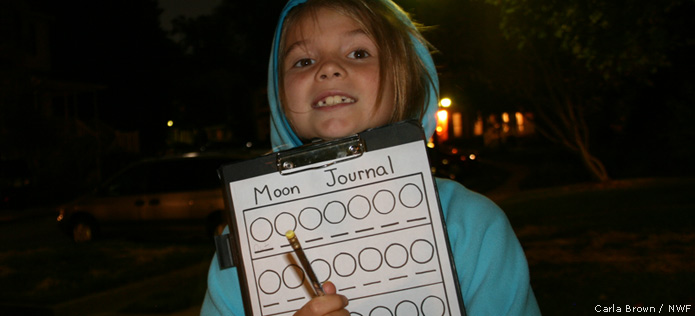
Get acquainted with the phases of the moon by keeping a moon journal.
What You Need
- Clipboard
- Moon Journal Print-out (optional)
- Pencil
- A quarter, if you want to draw your own circle
What You Do
Each evening, go outside with your child and try to find the moon in the sky.
Keep track of your observations on your Moon Journal print-out, or draw your own moon circles by tracing a quarter each day. In the circle, sketch the shape of the moon as you observe it.
For each observation, record the date, time, and—if you know it—the direction. If weather conditions keep you from observing the moon, make note of that, too.
Did you know the moon’s shape doesn’t actually change? It’s always round. What changes is how much of it we can see.
The side of the moon that faces the sun is brightly lit. The other side is unlit. We can see the sunlit part easily, but the unlit part is very faint, it if shows up at all.
Why does this happen? It’s because the moon travels around the Earth in an orbit. Check out this orbiting moon diagram. When the moon is between the Earth and the sun, the bright side is facing away from us and the moon looks totally dark. This is called a new moon. But when the moon is on the opposite side of the Earth from the sun, the whole sunlit side faces us and the moon looks full. All the other shapes appear in between those positions, as the new moon grows to full and then turns back to new once again.
These changing shapes are called phases of the moon. It takes 29.5 days (about a month) for the moon to orbit Earth. That’s why the moon cycles through all its phases in a month’s time.

2. Over the course of one month, make as many observations as you can.
A lunar month is the time between phases of the moon (ie., from one full moon to the next full moon). Based on your observations, how many days long is a lunar month? What do you notice about the time and direction you recorded in your first and last observations?
The moon follows the same approximate path across the sky as the sun but it may rise very early or very late, depending upon its current phase. Remember, too, that during the “new moon” phase, there will be no visible moon in the sky.

3. Look up lunar info for your area.
Find out when the moon rises and sets in your area and other fun lunar info by visiting the moon page of the Old Farmers Almanac.
You can check out your work with this calendar of this month’s moon phases.

